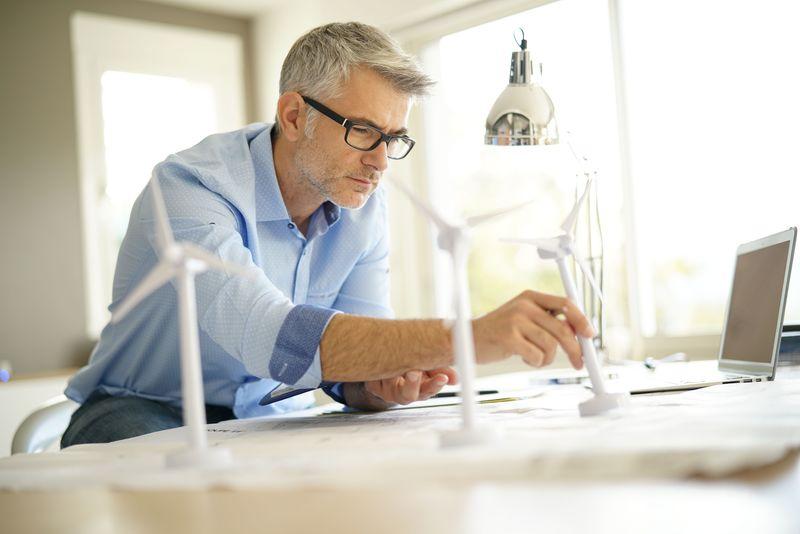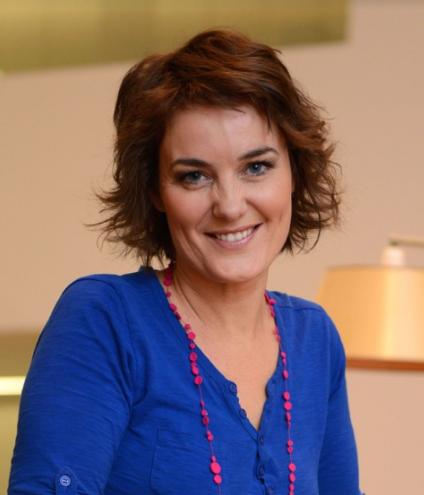How your company can make the successful transition to the circular economy
Consumers expect you as a product supplier or service provider to take action against climate change. But how should you approach this in the long and short term? And how do you get everyone in the company on board? We asked Evy Puelinckx, Belgium's Grande Dame of the circular economy.

"We should not expect solutions for climate change and measures for a circular economy to come from the government."
We are talking with Evy Puelinckx: architect, academic and social entrepreneur, but above all a champion of the circular economy. As a veritable Triple Helix, she forges links between the industrial, academic and governmental world. In this way, she wants to ensure that these parties can cross-fertilize each other in order to take steps towards circularity and sustainability.
Evy Puelinckx: "In terms of the climate, it's really already 2 minutes after midnight. We really need to get rid of the linear model for production and consumption. But we should not let the transition to a circular economy depend on government measures or laws. Reaching a consensus quickly is virtually impossible here. As a member of the Climate Council, I notice this in practice: the will is there, but it just takes a long time to get everyone on the same page. So it's up to the industrial world to take the lead. Companies are much more agile. Plus: it's what their customers expect from them."
Recent research conducted by AXA worldwide confirms this. Our annual Future Risk survey found that climate change is the number one concern of consumers today. Globally, pollution even ranks higher than fears of a new pandemic. To avert the climate catastrophe, customers are looking to the corporate world. Companies must do everything they can to carry out their business and production more sustainably – with as little pollution as possible. And they have to go beyond the all too familiar 'stopgap' solutions when it comes to sustainability. So no greenwashing actions.
Evy Puelinckx: "Companies would do well to listen to their customers and employees. The war for talent or the battle for customer loyalty ... they come down to the same thing. People prefer to work for and buy from an organisation they can be proud of. A company that is convincingly engaged in sustainable business and circular production will more quickly gain the engagement of valuable prospects and applicants. For that reason alone, the entire business world should now really work on the transition to a circular economy."
Circular model drives innovation
"Not only does the circular model use our resources more efficiently and reduces the impact of production and consumption on the environment. It also generates employment and saves on budgets." Evy Puelinckx
Circular economy is a production and consumption model in which products, raw materials and parts can be used for as long as possible and with the highest possible quality. This means that you have to continuously make sustainable choices – from design and manufacture to export, sale, reuse or dismantling. It challenges companies to think differently, and even change their business models. Circular manufacturers ensure that their products are repairable or reusable from the start. They extend their warranty to that that end . Or they rent or share their products in order to take them back – when they are 'used up' – to dismantle them, and to reuse the residual materials.
Evy Puelinckx: "As a circular designer or manufacturer, you look further. You consistently opt for a well-considered design and materials with a high recycling value. You ensure your product is easy to maintain, repair and upcycle. And: you only deliver what your consumer really wants and needs. You also guarantee that ease of repair and maintenance are an inherent part of your product. In this way you can ensure that – through a built-in insurance policy – people are automatically entitled to the repair when purchasing a product. This way, you create more value with one product and keep waste to a minimum."
So, a car manufacturer that does not supply its customers with a car, but tailor-made mobility? Take them to work, school, outings or hobbies and pick them up again?
Evy Puelinckx: "It seems like a utopia, but it is certainly not impossible. But: it requires quite a bit of a mental adjustment. And switching to a circular business model often has major consequences. For example, if a company opts for the product as a service approach, then the insurance issue arises. After all, if it is not you but the manufacturer who remains the owner of the car, who will pay the excess in the event of an accident? It is therefore important that discussions take place between sectors.
Still, I think that companies will soon discover that there are success stories to be found, and even profit in that circular thinking and sustainable production. Not only does the reuse ensure a more efficient use of resources, and it reduces the impact of production and consumption on the environment. It also generates employment and also saves on budgets."
Circularity: complex, but not impossible
"The sustainable choice should always be the most enjoyable, sexiest, really the only possible choice." Evy Puelinckx
Take-make-consume-throw away… That is the pattern on which the prevailing linear economic model is based. Large amounts of cheap, easily accessible materials and energy go through this cycle today. Often a built-in limited lifespan ensures that this happens at a relentless pace. Circular economy breaks radically with this model.
Evy Puelinckx: "But circularity is complex. Take a toothbrush: which design is the most sustainable? It is one of the questions I pose to my students at the University of Antwerp. Is it really better to replace a plastic toothbrush with a bamboo model if the raw material for it is imported from China? Wouldn't it be better to design a rubber model made with local recycled materials? Or switch radically to chewable tablets, packaged in glass bottles?"
Because of that complexity, according to Evy Puelinckx, you should not make consumers responsible for the circular economy. Companies and the government should make it super easy for them to live sustainably. They must ensure that sustainable consumption is always the most enjoyable, but above all the most effortless and convenient choice.
Long-term transition: every decision counts
How does a company start a transition to circularity? How can they incorporate that new mindset into their strategic decisions and day-to-day operations?
Evy Puelinckx: "You cannot install a circular corporate culture overnight. It is a road that companies have to travel at two speeds. In the long term, you determine a policy top-down and record it. You take a closer look at the bigger picture: are innovations needed, do you have to retrain people, do you have to change the business model? The aim is to have a circular mindset and approach in place after five years."
- Transfer your vision top-down. Installing a circular corporate culture requires focus, vision and time. It is a process that must be managed continuously and from the top down. Only then does it have a chance of success. For example, it is the CEO who decides with his board of directors to only work with circular materials, even if they are more expensive. Or encourages his employees to come up with alternatives to harmful tools or materials.
- Challenge your business model. But how do you reconcile sustainability with making a profit? How do you construct a sustainable business model? For this, companies can consult economist Kate Raworth. In her worldwide bestseller, Doughnut Economics: Seven Ways to Think Like a 21st Century Economist, Raworth creates an economic model that brings the social and ecological dimensions together in a simple economic model. This can serve as a thinking framework that guides governments, businesses and civil society organisations in their decisions and actions. And helps them to meet the challenge of the 21st century for humanity: provide in everyone's essential needs without depleting the earth's resources. a clear
- Check every decision. Together with the University of Hasselt, Evy Puelinckx is now developing a simplified decision model based on Raworth's framework. It is a tool with which you can easily test the impact of your actions and decisions against 4 circular parameters: local, global, ecological, social.
- Explain what sustainability means. Make sure your buyers, designers, workers, HR team and even cleaning staff know exactly what is expected of them. Give them clear guidelines that make it easy for them to act sustainably. For example, you can say that employees only receive a fairphone: a smartphone that has been manufactured with social responsibility, and that can be easily repaired.
- Make it easy for your customers. Guide your consumers in the same way: offer them clear and objective information about the circular qualities of a product. But do make sure to keep it very simple: with a label, for example, you know at a glance which product, service or provider is the better choice. In this way, consumers can effortlessly opt for sustainable products.
- Involve your CSR manager in everything you do. The CSR manager should give input on all or at least the most important decisions in the field of HR, marketing, research & development and operations. Companies that do not have a CSR manager can work with external CSR advisers or third parties.
- Scale up where possible. Scaling up is the fastest and most efficient way to operate sustainably and create positive impact. For example, facility managers can decide to use natural cleaning products in all the buildings they manage. Or to synchronize renovations and only use sustainable materials.
- Put the right people to work. To make a circular transition a success, a company often needs people with different skills and a different mindset. HR can take this into account when issuing job listings for new employees, or when offering training and education to its own staff.
- Give forward thinkers space. To make circular innovation a success, you need people who dare to think ahead, experiment and fail. A company therefore does itself a great service by listening to their ideas.
- Be transparent. In telling the sustainable story, there's no need to bend the truth. It tells itself. However, it pays to be transparent if sustainability is not yet what it should be everywhere in a company. Do not hide this, but openly explain what you have already achieved and what you are still working on.
Short-term transition: make it tangible
"Transforming your company into a circular organisation is quite a journey. But as with any journey, it all starts with the first small step."
Companies do not immediately need to have a long-term plan or new business model ready to get started with sustainability. In the short term, they can set up projects that make the circular economy tangible and meaningful. Projects that instantly yield results and are experienced as success stories by their employees and customers. In this way, they are stimulated to think and innovate sustainably.
According to Evy Puelinckx, this is the key to a successful transition: let people experience the benefits and fun of circularity and nudge them in a positive way to actively engage with it. By working on a small scale with sustainable choices, recycling or upcycling, you automatically create a mindset for circularity on a large scale. To get companies going, Evy Puelinckx founded The Circular Agency. Together with a company, the agency creates a project plan that helps them bridge the first few years until their long-term strategy is in place. It organises maker's labs, team building activities, sustainable choice models and urban mining projects that plant seeds for a new mindset in the company.
Evy Puelinckx: "Small-scale projects can have a huge impact. Take promotional gifts. For KBC, we used The Circular Agency to make attractive laptop bags from discarded promotional banners from the bank. Not only did the bank give its banners a second life, it turned them into coveted gadgets that convey their circular story to employees, customers and partners. That is the whole point of sustainable business: that you are very concrete, practical and, above all, work at it constantly. This way, your marketing department no longer has to worry about your communication. You don't even have to think about your story: it's ingrained in your actions."
- Let people experience it. Through teambuilding and maker's labs, everyone, from manager to worker, makes new products from residual material. In this way, they start to see waste as a gift, and they learn to see used materials as a source of raw materials. And you create new circular, valuable and often surprisingly innovative objects, interiors or events. In a next step, this can then be extended to further initiatives internally.
- Draw up a master plan for 3 years. Make a quick scan of your company and see where you can score quick wins. For example, switch to natural cleaning products. Draw up a step-by-step plan in which you clearly record what happens to discarded office furniture, PCs or smartphones.
- Urban mining: exchange residual flows. Via 'urban mining', a company offers its residual materials to those who can give them a second life. Evy guides companies that are planning to renovate and redesign. Evy Puelinckx: "For example, over the past year we have helped many victims of the flooding in Wallonia to rebuild their homes by reusing materials from existing buildings. But these recycled materials can also be used by the company itself, as raw material for the furnishing of the new coffee corner, for example."
- Generate enthusiasm in your environment. The most important thing is to get people excited. You do this with small projects that appeal to the imagination, such as making laptop bags from discarded facade banners.
On the right track
Over the past few years, we have taken steps in the right direction when it comes to sustainability. The UN's Sustainable Development Goals have put social and sustainable issues on the agenda. And there is the European Green Deal, which transforms the EU into a modern, resource-efficient and competitive economy.
Evy Puelinckx: "There is still work to be done before we can effectively become the first climate neutral continent. Waiting for legislation or regulations or looking to see what others do will not help us move forward. It is now up to industries and companies to take a clear position towards their own employees and towards customers and stakeholders. And to translate a sustainable policy into small and large concrete initiatives. And that only works if the mindset is right at C-level."

Meer over Evy Puelinckx
In addition to being an architect, designer and academic, Evy Puelinckx is a passionate social entrepreneur, author and speaker. From an early age, sustainability and circularity have been the common thread in everything she does. As a consultant, teacher or business trainer, she wants people to experience first-hand the opportunities the circular model has to offer. With her consultancy and design company, she offers other entrepreneurs added value through story-doing, not story-telling. She helps companies analyse materials and procedures and shows them where to find opportunities. Some of the companies she works with are Tomorrowland, IKEA, Samsung, Telenet and BondZonderNaam.


